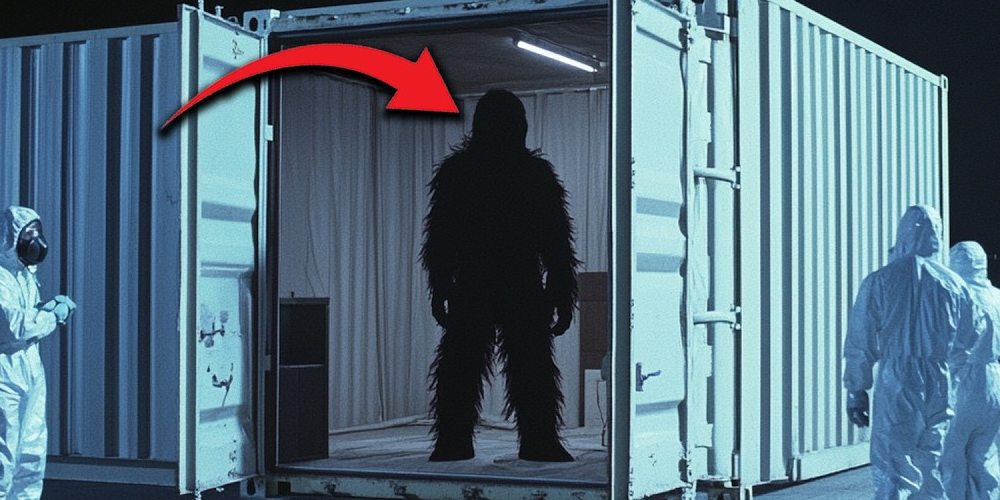Something strange is happening at America’s ports, and it’s leaving experienced workers baffled. Among the millions of containers that move through our shipping infrastructure daily, some don’t follow the rules—containers that seem ordinary at first glance but operate entirely outside the system we know and trust.
Here’s a closer look at how seasoned workers uncovered a pattern of strange activity and why it’s raising serious questions.
A Shipping System Supposedly Without Gaps
Ports run like clockwork. Every container has a code. Every shipment has paperwork. Every move is logged. The entire system is designed to keep track of goods moving through.
But for months, workers have been spotting containers that somehow slip through the cracks. These containers don’t follow standard patterns. They weigh more than they should. Their paperwork marks them as empty, yet their movement suggests otherwise.
What’s more, equipment around these containers often fails without explanation—scales, temperature sensors, GPS systems, and even phones mysteriously stop working. And then there’s the security. Teams that no one recognizes show up, handle the containers, and vanish. No uniforms. No markings. Just quick, efficient work like they’ve done this a hundred times before.
The First Clues: Port of Long Beach
Two months ago, a veteran customs inspector at Long Beach saw something so odd, he couldn’t let it go. A container with the number KZU 7793554 had a format different from any he’d seen in 15 years. Standard containers have four letters and seven numbers. This one had eight numbers.
The paperwork said it was empty, but the scale told a different story—27,000 pounds instead of the 5,000 pounds typical of empty containers. When he tried to flag it in the system, his entire computer crashed. By the time systems rebooted, the container was gone—moved in minutes by a crew and equipment no one recognized.
The next day, it was as if the container never existed. Its spot on the shipping manifest had been replaced. Security footage of those 20 minutes? Blank.
The inspector started watching, and he saw more of these containers. Same odd number formats. Always heavier than they should be. Always “empty.” Always moved by unfamiliar crews.
One night, he got close enough to hear something coming from inside. It wasn’t machinery. It wasn’t cargo shifting. It was… something else.
Survival Beef on sale now. Freeze dried Ribeye, NY Strip, and Premium beef cubes. Promo code “jdr” at checkout for 25% off! Prepper All-Naturals
Crane Failures and Impossible Cargo
A crane operator with 20 years of experience shared his own unsettling encounter. He could lift almost any container blindfolded—it was part of the job to “sense” how containers move. But three months ago, he came across one that didn’t feel right.
The container, KZU 77951 Z2, was marked empty. But when he lifted it, his instruments failed. The weight sensor went dead. His radio stopped working. Even the container itself swayed unnaturally, like something inside was moving deliberately.
And the strangest part? The panels on the side of the container. They weren’t standard cooling panels but something far more advanced. When he got close, he heard a humming sound that made his teeth hurt. His attempts to document the oddities failed—his phone shut off, and the photos he’d previously taken turned to blank screens.
The Worker Who Looked Too Close
Sometimes, damaged containers need inspection. One night, a night shift worker approached a cracked container. What he found inside still haunts him.
Don’t wait for a stock market crash, dedollarization, or CBDCs before securing your retirement with physical precious metals. Genesis Gold Group can help.
Through the crack, he saw movement. At first, he thought it was shadows. Then, he realized: it was massive, at least seven feet tall. Its skin looked alive, neither fur nor scales, shifting like liquid adapting to the darkness. Its eyes? Too large and too aware, reflecting light like an animal’s but with an intelligence he could feel.
Then came the smell. Like ozone and wet dirt but with an unnatural sting. His flashlight flickered off. His phone died. And the sound—it was a low vibration, almost like a growl, at a pitch that rattled his teeth.
Within minutes, men in unmarked uniforms arrived. They labeled it a chemical leak, cleared the area, and moved the container using specialized equipment. The next day? No record of damage. No sign anything had happened at all.
Inside the Cold
Even maintenance workers aren’t spared these strange encounters. One man, responsible for container refrigeration units, got called to check a malfunctioning sensor.
Most refrigerated containers don’t go below -20°C. This one read -80°C—impossible. Its equipment wasn’t standard, and it drew massive amounts of power for unknown purposes.
A reinforced viewing panel caught his attention, and despite his better judgment, he looked inside. Behind the frosted glass, a massive shape moved, deliberate and fluid. It seemed to shift as though it couldn’t decide if it wanted to be solid or liquid.
When its eyes turned toward him, they didn’t just reflect his light—they absorbed it. Then the sound came: a deep, bone-rattling thrum that felt alive. The worker backed away, only to find himself confronted by men in Hazmat gear. They questioned him for hours, forced him to sign non-disclosure agreements, and transferred him to a different job the next day.
Why Hide in Plain Sight?
The evidence is overwhelming. Mysterious containers marked as empty but far too heavy. Equipment malfunctions that seem intentional. Security teams who appear, handle the situation, and leave without a trace.
But why shipping containers? What makes these metal boxes the perfect cover?
It’s simple: ports are chaos in motion. With millions of containers piling up each year, who’s going to notice a few anomalies? Beyond curious workers, these containers become near-invisible, blending into the endless rows of standardized cargo.
And wherever these containers go, they leave no trace—no logs, no photos, no records. Just silence.
Conclusion
These strange containers keep appearing, moving, and disappearing. Their cargo remains unknown, though the firsthand accounts paint a chilling picture. Workers quit jobs. Equipment fails. Stories get buried.
Next time you see a shipping container on the highway, take a closer look. If you spot one starting with KZU, think twice before getting too curious.
If you’ve ever seen anything that doesn’t add up, there might be others who’ve noticed, too. Share carefully. Some secrets seem determined to stay hidden at any cost.

It’s becoming increasingly clear that fiat currencies across the globe, including the U.S. Dollar, are under attack. Paper money is losing its value, translating into insane inflation and less value in our life’s savings.
Genesis Gold Group believes physical precious metals are an amazing option for those seeking to move their wealth or retirement to higher ground. Whether Central Bank Digital Currencies replace current fiat currencies or not, precious metals are poised to retain or even increase in value. This is why central banks and mega-asset managers like BlackRock are moving much of their holdings to precious metals.
As a Christian company, Genesis Gold Group has maintained a perfect 5 out of 5 rating with the Better Business Bureau. Their faith-driven values allow them to help Americans protect their life’s savings without the gimmicks used by most precious metals companies. Reach out to them today to see how they can streamline the rollover or transfer of your current and previous retirement accounts.
Coffee the Christian way: Promised Grounds



